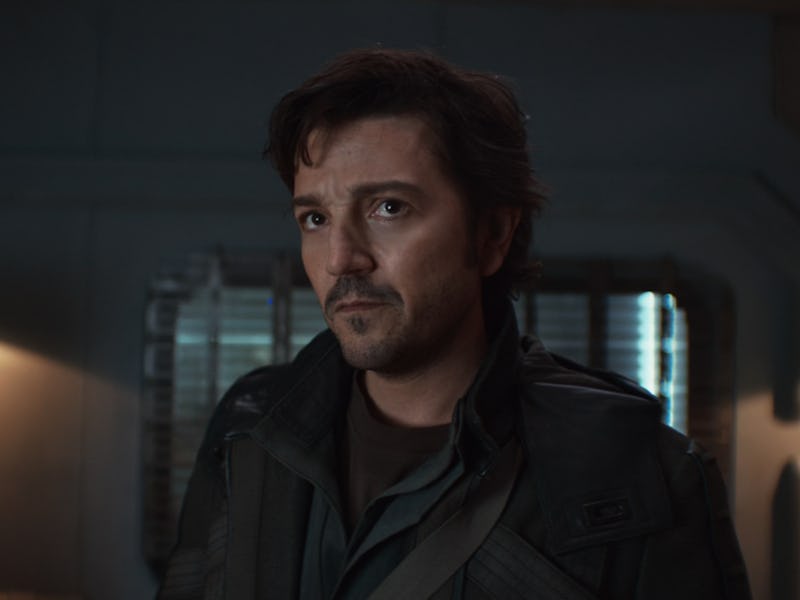Andor Season 2’s Time Jumps Are Becoming The Show’s Most Glaring Problem
As Andor pitches into its third major time jump, the cracks in this narrative are showing more than ever.

Andor Season 1 was so good mostly because it took its time. It spent 12 episodes tracing a year in the life of its reluctant hero, Cassian Andor (Diego Luna), as he became embedded in the Rebel Alliance. Cassian’s story was originally set to run for four more seasons, each following one year leading up to his fatal sacrifice in Rogue One. But showrunner Tony Gilroy couldn’t exactly commit to that huge a series, leaving him to cram the rest of Cassian’s tale into 12 more episodes.
Gilroy recently spoke to Rolling Stone about the process of building the season out within those new parameters. The writer recalls the “breakthrough” of spreading four years of Cassian’s story across 12 episodes, with a one-year time jump occurring every three episodes. “The next revelation was, ‘Oh, my God, it would be so cool and elegant and smart if when we came back, we only came back for two or three days,” Gilroy explained. “If we came back in these really concentrated periods of time... Could we really elegantly let that negative space work in our favor?”
Andor Season 2 has worked to answer that question with mixed results. Each arc hopskotches through the Star Wars timeline with as much elegance as it can, trading what Gilroy calls “naked exposition” for more realistic, immersive writing. We’re brought up to speed through context clues and a “show, don’t tell” conceit — and it’s worked well enough so far. Andor finds clever ways to navigate its time constraints. Even with its elevated story, though, its tactics have their limits. As Andor pitches into its third major time jump, the cracks in this narrative are showing more than ever.
Spoilers ahead for Andor Episode 7.
Andor has used its time constraints to its advantage, but Episode 7 shows the cracks in this story.
Andor Episode 7 picks up a year after Episode 6, which brought us into the political strife on the planet Ghorman. The Rebellion was still a dangerous, disorganized mess when we last saw Cassian — but a lot has changed when we catch up with him this week. Both Cassian and his longtime girlfriend Bix Caleen (Adria Arjona) have severed their ties with spymaster Luthen Rael (Stellan Skarsgård) and relocated to the Rebel base on Yavin IV. The organization there is a far cry from the chaos at the beginning of Andor Season 2, more closely resembling the Rebel front in Rogue One.
We’re mostly brought up to speed through conversations with Cassian, Bix, and fellow Ferrixian Wilmon Paak (Muhannad Ben Amor). They tell us that Luthen’s accelerationist tactics have driven him further from the larger Rebellion, which clearly prefers to play things safe. After Wilmon’s time with Saw Gerrera (Forest Whitaker), he finds himself on the more radical side of the Rebel spectrum, and is now embedded with the Ghorman Front. The series also shows us exactly how the Rebels on Yavin live — a first for the Star Wars saga — but it’s not quite enough to distract from the gaping holes in this story.
This time jump raises questions about how Cassian, Bix, and Vel Sartha (Faye Marsay) broke off from Luthen’s faction, or how the larger Rebellion organized itself so quickly. The past six episodes of Andor have been so focused on splintered Rebel cells — Luthen’s group, Saw’s Partisans, the Ghorman Front, and others — that we never get to see the actual Rebellion take shape. It’s not all bad, but it’s frustrating to circle back to the Yavin Rebels only once they’ve fully organized themselves off-screen.
Andor’s third time jump robs us for the answer we’ve been seeking all season.
Andor Episode 7 tries to distract us from its blindspots with the urgency of a new mission for Cassian, but the frustration is only multiplied the more he brushes up against Rebel life on Yavin. The series reintroduces us to Dravits Draven (Alistair Petrie), Cassian’s direct supervisor in Rogue One. He pops up to reprimand him when he decides to follow Wilmon back to Ghorman, but at no point does Andor remind us who he is or how he’s significant to the Rebellion. Is he the boss of the operation on Yavin? Was he the one to recruit Cassian? We may never find out, because Andor isn’t interested in answering those particular questions.
With only 12 episodes at its disposal, Andor can’t exactly tell a story as straightforward as its first season. It keeps its focus on a handful of characters and locales, and that connective tissue does mostly give Season 2 the cohesion it needs. But it’s hard not to think about the story we’re losing with that approach, especially the closer Andor gets to catching up with Rogue One. The series is determined not to give us too much exposition, to jump forward in time as naturally as possible. But that strategy is robbing us of the questions fans have had since Andor was first announced. Cassian is admittedly the focus here, not the Rebellion, but given his importance to the cause, it just doesn’t feel like the prequel he deserves — nor the prequel fans were promised.